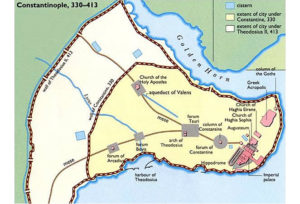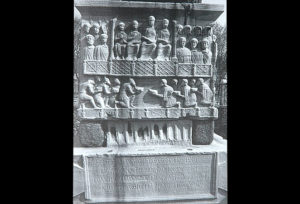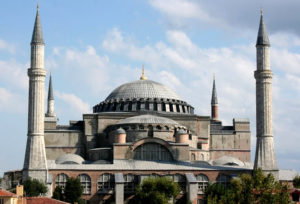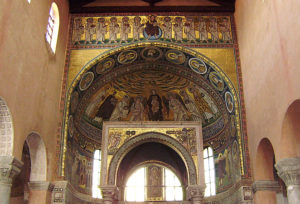Byzantine Empire
Eastern Roman Empire or Byzantium rose to existence by the foundation of the city Constantinople in 324 AD, and the final division to Eastern and Western Roman Empire did not happen until 395 AD. It lasted until the year 1453 when the Turks conquered Constantinople. Though the Byzantines emphasized their Roman origins, as time passed, they gradually distanced from their roots. The culture and language are more and more influenced by the Hellenization of the Empire and its theocracy.1 Byzantium had a prominent position among the medieval states of that time. It was prominent for its unique organization of government, excellently equipped army with a remarkable war technique, developed economic and monetary system, and above all that it was enormously wealthy.2 One of the most famous byzantologists G. Ostrogorski described the Byzantine Empire thus: „Roman government, Greek culture and Christianity are the key foundations of the Byzantine development. A lack of any of those elements would unhinge the very existence of Byzantium. Only by the congregation of Hellenic culture and Christianity with the Roman statehood could emerge such a historical entity that we call the Byzantine Empire. “3
The construction of Constantinople
 The city was named after its founder, the emperor Constantine. The slavenic people called it Tsargrad, and it got its current name Istanbul after being conquered by the Turks. The emperor Constantine spent much time on the Eastern borders of the Empire due to the war with Germania, so he mostly resided close to Little Asia, and rarely in Rome. That could be an explanation of why he chose this location to found a new Empire’s capital.
The city was named after its founder, the emperor Constantine. The slavenic people called it Tsargrad, and it got its current name Istanbul after being conquered by the Turks. The emperor Constantine spent much time on the Eastern borders of the Empire due to the war with Germania, so he mostly resided close to Little Asia, and rarely in Rome. That could be an explanation of why he chose this location to found a new Empire’s capital.
After the “New Rome “was founded, it was built and expanded rapidly. Many buildings were built, including the new Hippodrome, palace, forums, administrative and clerical buildings, and the city was decorated with bronze statues. The emperor Constantine himself expanded the city four or five times. It was modelled in Roman style, though it was, unlike Rome, a Christian city from the start. In Rome, churches were built outside the city walls, while in Constantinople churches were built in the city itself.4 The bishop’s palace was built next to the emperor’s, which meant a bond between the holy and empire (emperor’s power being connected to religion). The cathedral and bishop’s residence were located in the narrow centre, close to the Senate and the secular government. Following the fall of the Western Roman Empire, the Christian Empire continued evolving here, but it became Greek by its language and culture.
The emperor’s palace, known as Daphne, which was located near the Hippodrome, would later become the main palace of the Byzantine Empire. The city also had wide avenues with sidewalks for pedestrians and merchants, which are significant for the eastern cities. They were discontinued by forums. One of them was Constantine’s forum, which was circular, unlike the Roman forums, and it had a pole with the bronze statue of Constantine on top, in the figure of God of the Sun.5
The statues were appointed all over the city. They were pagan, but since they were extracted from the pagan temples, outside its religious context, they had merely a decorative function. Of all the statues, only one group was preserved – the horses that stood at Constantine’s Hippodrome.
Emperor Theodosius
 Theodosius was the last emperor who ruled the complete Roman Empire. He brought relative political stability to the Empire by giving certain privileges to the Barbarians. For instance, with the Germans he made a pact (“foedus “) according to which the Germans had full autonomy, but were obliged to provide military service for the emperor whenever needed.6 He issued edicts that prohibited any pagan cults and forced closure of the pagan temples, as well as banned religious sacrifice. Pagan art had no useful function anymore, although it was still preserved. Before his death, in 395 AD he appoints his son Arcadius as the ruler in the East and Honorius as the emperor in the West. The Empire was thus separated, and Constantinople becomes rival to Rome. The Western Empire falls in 476 AD, while the Eastern survives, becoming the Byzantine Empire. It was Roman in its origin, but culturally and linguistically Greek, and essentially Christian.
Theodosius was the last emperor who ruled the complete Roman Empire. He brought relative political stability to the Empire by giving certain privileges to the Barbarians. For instance, with the Germans he made a pact (“foedus “) according to which the Germans had full autonomy, but were obliged to provide military service for the emperor whenever needed.6 He issued edicts that prohibited any pagan cults and forced closure of the pagan temples, as well as banned religious sacrifice. Pagan art had no useful function anymore, although it was still preserved. Before his death, in 395 AD he appoints his son Arcadius as the ruler in the East and Honorius as the emperor in the West. The Empire was thus separated, and Constantinople becomes rival to Rome. The Western Empire falls in 476 AD, while the Eastern survives, becoming the Byzantine Empire. It was Roman in its origin, but culturally and linguistically Greek, and essentially Christian.
From the base of the obelisk posted by emperor Theodosius, formerly residing at the Hippodrome, we can see the trend in the sculpture of that period. The emperor is displayed as the ruler of Persians and Goths who brings him presents. Sitting next to him is his western co-ruler, and next to him Theodosius’ sons Arcadius and Honorius. The emphasis is not on the individuals but the political hierarchy. The sculpture also shows a rising aversion towards the figuration and narrativity of the classical sculpture, while the sculpture itself becoming more ornamental. It becomes closer to the provincial art featured by frontality, torpidity and disproportionality.
Emperor Justinian
 Justinian is one of the most notable of Byzantine emperors, who, for a short period, succeeded in reconnecting the areas of the Western and the Eastern Roman Empire. He fought against the Vandals (north Africa), the Ostrogoths (Italy), the Visigoths (Pyrinees)… During his conquests, he never took account of the new perils that started threatening the Empire. Those perils were the new, strong Persia, and the unstable northern border on the Balkan Peninsula. Justinian tried to solve the Balkan border problem by constructing a dense network of fortifications, but it did not prove to be especially successful as a solution. The peace was not made until Byzantium made a treaty with Avars, who were from then onwards obliged to keep the peace on the Balkan Peninsula.
Justinian is one of the most notable of Byzantine emperors, who, for a short period, succeeded in reconnecting the areas of the Western and the Eastern Roman Empire. He fought against the Vandals (north Africa), the Ostrogoths (Italy), the Visigoths (Pyrinees)… During his conquests, he never took account of the new perils that started threatening the Empire. Those perils were the new, strong Persia, and the unstable northern border on the Balkan Peninsula. Justinian tried to solve the Balkan border problem by constructing a dense network of fortifications, but it did not prove to be especially successful as a solution. The peace was not made until Byzantium made a treaty with Avars, who were from then onwards obliged to keep the peace on the Balkan Peninsula.
The most notable Justinian’s work was the codification of the Roman law, a collection of codes which finally constituted the Corpus iuris civilis. Furthermore, he consolidates the monetary economy by the coinage of golden money (hyperperos). The general economy is further developed, and the silk industry becomes the major economic branch.7
He was an activator of construction in the Empire, he started construction of thirty-three churches. The period of his reign was a time of enormous progress. The imperial workshop (in which various luxury items were made) flourished. Art craftsmanship also experienced large progress in his time.
Haghia Sophia
 The church dedicated to the divine wisdom, was built from 532 to 537 AD, and the architects that designed it were Isidore of Miletus and Anthemius of Tralles. The construction was initiated by the emperor Justinian, to build the finest building of all times, which shows an ambition to restore the Roman Empire. He wanted to build an unmatched structure, which would pose as a monument to the glory of the Church and a symbol of the superiority of Constantinople over Rome, and at the same time it would have been a cenotaph to Justinian’s restoration of the Roman Empire.
The church dedicated to the divine wisdom, was built from 532 to 537 AD, and the architects that designed it were Isidore of Miletus and Anthemius of Tralles. The construction was initiated by the emperor Justinian, to build the finest building of all times, which shows an ambition to restore the Roman Empire. He wanted to build an unmatched structure, which would pose as a monument to the glory of the Church and a symbol of the superiority of Constantinople over Rome, and at the same time it would have been a cenotaph to Justinian’s restoration of the Roman Empire.
The Church itself dominates the landscape of Constantinople. It has some elements of a basilica, but still differs in the construction of the dome and semi-dome, and its layout is almost quadratic, walls discontinued by the side naves, colonnades and galleries, rising through the semi-domes and four enormous pandatives to the incredible dome, that reminds of a shallow plate, with a diameter only 2,40 meters smaller than the one on the cathedral of St. Paul in London. It is a forty-window dome, which, by the words of a contemporary,looked not like residing on the firm ground but as if covering the space descended on golden chains from heaven.8 They didn’t spare on precious materials, and the workers came from all the parts of the Empire. Eight different kinds of marble were used for the sheeting of the inner walls. The porphyria walls came from Egypt, the green marble was hewn in Greece, and the entire Church was covered in mosaics. A description of Haghia Sophia from the 6th century mentions a golden altar covered in jewels, numerous chandeliers, woven golden drapes, silk curtains… A silver septum separated the eastern apse with two doors for priests and twelve columns entirely mounted in silver. The upper galleries preserve the only saved mosaics from the time of Justinian when originally the whole Church was covered with mosaics.
Two important churches of this period, whose construction was also initiated by Justinian, are the Church of Saints Sergius and Bacchus and Haghia Irena.
Euphrasian Basilica
 Euphrasian basilica was raised in the 6th century, during the period of emperor Justinian and bishop Euphrasius, who it was named after. The pontifical complex was preserved entirely, which is a rarity in the architecture of that period. The building complex comprises of the baptistery, atrium (the north porch of the atrium serves as nartex at the same time), the Church and the bishop’s court. Nenad Cambi explains the functionality of the bishop’s court thus: “At the court of the bishop, that comprised of a ground floor and two upper floors, ceremonies were held, as well as admittances and other representative functions of the bishop as the head of the Church in Poreč. “. 9
Euphrasian basilica was raised in the 6th century, during the period of emperor Justinian and bishop Euphrasius, who it was named after. The pontifical complex was preserved entirely, which is a rarity in the architecture of that period. The building complex comprises of the baptistery, atrium (the north porch of the atrium serves as nartex at the same time), the Church and the bishop’s court. Nenad Cambi explains the functionality of the bishop’s court thus: “At the court of the bishop, that comprised of a ground floor and two upper floors, ceremonies were held, as well as admittances and other representative functions of the bishop as the head of the Church in Poreč. “. 9
One of the most representative parts of the Euphrasian basilica are its mosaics which are located in the building’s apse. Apart from the artistic value itself, the mosaics also have an important iconographic program. The Virgin Mary is placed at the centre of the apse, at a place regularly reserved for the Christ. She sits on a throne, with the little Christ in her lap, blessing with his right hand. Both sides are inhabitted by the two groups lead by angels. On the left side, there are three martyrs holding wreaths in their hands. On the other side is St. Mauro, also holding a wreath, but has a name written beside his aureola. Next to him are, standing, the three contemporaries of that period, still alive at the time when they were displayed there. They are the bishop Euphrasius, holding a model of his basilica in his hands, archdeacon Claudius, who was Euphrasius’ brother, and Claudius’ son, the boy named Euphrasius. In the lower part of the triumphal arch, there are thirteen circular medallions. In the central area, Christ is shown as Agnus Dei, and on each side, there are six more displaying various saints. In the highest portion of the apse, there is a frieze with apostles and the Christ in the middle.
Following the “golden age “of the emperor Justinian the Empire starts to weaken, mostly due to the wars with Persians. “The Langobard intrusion in Italy in 568 AD meant a loss of a large part of the Apennine Peninsula. At the same time, the northern defence failed as well, that is against the Slavic attacks. “10
Other articles from the series: “The Art of Byzantium”
- The city Constantinople got its name after its founder, Emperor Constantine
- Constantinople was known as Tsargrad in the Slavic nations, and it got its today’s name Istanbul after being conquered by the Turks
- Haghia Sophia was built as a church after the Turkish conquer it became a mosque, and today it is a museum
- Emperor Justinian (6th century) only briefly succeeded in reuniting the Western and Eastern Roman Empire
- NENAD CAMBI, Antika, Naklada Ljevak, Zagreb, 2002.
- MELITA TOMAŠEVIĆ (ur.), Povijest svijeta, Split, 2005.
- THOMAS F. MATHEWS, Byzantium, From Antiquity to the Renaissance, Perspectives Prentice Hall, inc., Harry N. Abrams, inc., New York, 1998.
- JOHN JULIUS NORWICH (ur.), Velike arhitekture svijeta, Marjan tisak, Split, 2005.
- 1 MELITA TOMAŠEVIĆ (ur.), Povijest svijeta, Split, 2005., 333.
- 2 MELITA TOMAŠEVIĆ (bilj. 1), 333.
- 3 MELITA TOMAŠEVIĆ (bilj. 1), 333.
- 4 THOMAS F. MATHEWS, Bizantium, From Antiquity to the Renaissance, New York, 1998., 21.
- 5 Usp. THOMAS F. MATHEWS (bilj. 4), 18-21
- 6 Which the Emperor Theodosius closed at the end of the fourth century.
- 7 MELITA TOMAŠEVIĆ (bilj. 1), 333.
- 8 MELITA TOMAŠEVIĆ (bilj. 1), 336.
- 9 JOHN JULIUS NORWICH,Velike arhitekture svijeta, Marijan tisak, Split, 2005., 84.
- 10 NENAD CAMBI, Antika, Zagreb, 2002., 245.
- 11 MELITA TOMAŠEVIĆ (bilj. 1), 336.
Being half Greek and of Byzantine(Roman) heritage I find this very interesting.
Hey Great Job! You should put some stuff on how the Byzantine Empire fell too. Awesome research!!
Great Stuff But Its Preety Hard Tuh Understand.
This is very, very helpful. I was absent a day of school and needed to fill out a video guide, but I missed the video. I typed in the subject, and found this website. It gave me all the information I needed to complete the assingnment. Thank you and I hope I can use this website more often. 😀
Congratulations for your well done report which I was pleased to read. I have been many times in Constantinopolis and a few times I went visiting Agia Sophia, the remains of the Roman walls and whatever else left by the great Roman and Byzantine civilization; it’s sad to see that a great empire fell to the Turks that transformed Agia Sophia in a mosque: respecting history, at least, would have proven the invaders to have some degree of civilization but it appears it was not the case. Anyway congratulations for your web site.
Nicely done! You guys just helped my with a major project I have to do in my World Studies class. Thank you so much! And this wasn’t very hard to understand..You just have to be smart to. ;D
its really interesting
i liked it 🙂
This site just really helped me write a paper, thank you for all the helpful information.
GREAT JOB , helped me a lot on an essay i had to do great work. !!!! 😀
this was soooo helpful to me . I have an essay that I’m writing and i needed all of this and im so glad this is here for me to get information from. 😀
I really like the website on how its decorated and facted filled. Great job!!
thanks so much this helped me on my paragraph i had to write
it was helpful on my homework and the webpage is really cool.
I am writing an essay and thanks to this website I got a 97% on my essay.
Thanks to this website I got a 100
Quite interesting
thanks a lot for this info
I really like this website. It helps my kids with their homework!!
thanks for the info
Hurrah, that’s what I was exploring for, what a stuff!
present here at this blog, thanks admin of this web site.
This is a good website I mostly got all of my notes from this website but I will need to know if this is true thing from the rise of the Eastern e,pore.
I have been checking out many of your posts and i can state nice stuff.
I will definitely bookmark your website.
This is very helpful and useful.
you’re a lifesaver
This is a great work, it has really helped in finding more about my course of study
This piece of work has really been of great help to me in carrying out my research.
This is a very good and informational source. Hey guys lol